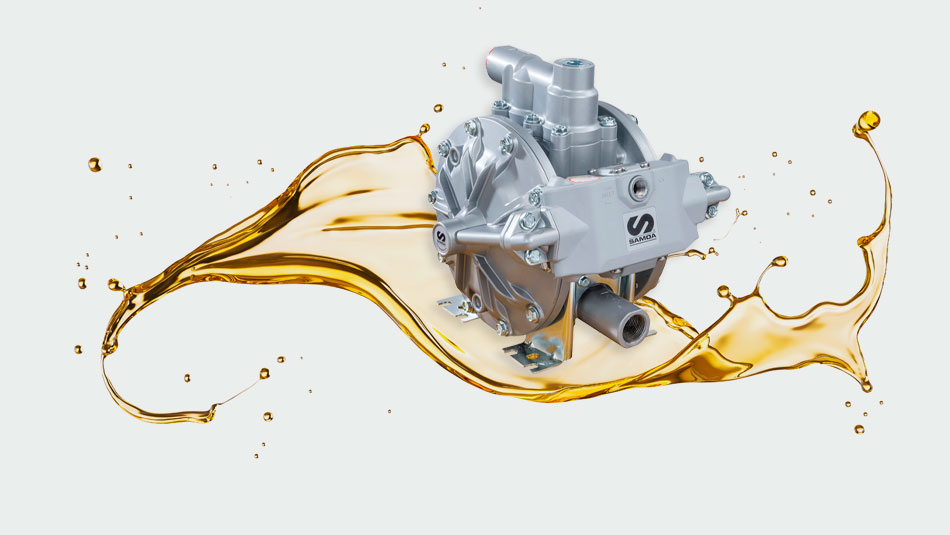What is the purpose of pneumatic pumps in the energy sector?

Everything you need to know about the purpose of pneumatic pumps in the energy sector
Whether for energy distributors, manufacturers or operators, pneumatic pumps are essential equipment. They enable the pumping, dosing and mixing of viscous and/or corrosive fluids. Discover the operation of this type of displacement pump and all its specifications.
Need advice?
Our team of experts is here to help you.
You can contact us via a simple click:
The operating principle of pneumatic pumps
Although pneumatic pumps, like all hydraulic systems, can suck in, transfer or dose different types of liquids thanks to variations in pressure, their main particularity lies in their operating principle.
These reciprocating pumps use the motor energy of compressed air. In other words, compressed air is the motor that produces the mechanical energy necessary to create the movement and suction of the fluids.
There are two types of pneumatic pumps: piston pumps, which are ideal to transport viscous products, and diaphragm pumps, which tolerate all types of fluids, including the most aggressive or corrosive.
In the energy sector, we recommend the use of dual-action pneumatic systems, i.e. with a double diaphragm.
In these models, the pump body consists of two chambers. Each is equipped with a ball check valve and is divided into two by a diaphragm.
When the compressor sends air into the first chamber, the diaphragm rises. The ball descends and closes the air intake valve. At the same time, the liquid is pushed upwards to cause its evacuation.
As the two diaphragms are connected by a common shaft, the one that is situated in the second chamber performs the opposite movement. The ball rises, closing the upper valve to create a vacuum that enables the discharge of the fluid.
At this time, the slide valve moves to the other chamber to enable the same cycle to begin in the opposite direction.
Why choose a diaphragm pump?
Diaphragm pneumatic pumps are almost universal. They are used at every step in the energy sector:
- During production, whether for fossil fuel plants, thermal power plants, for the production of biofuel, biogas, or hydrogen and other chemical products, etc.
- For transport on double-hull tankers, tanker vessels, etc.
- For the storage of fuel in shipyards, the filling of gas cylinders, etc.
- For energy distribution: natural gas stations, LPG, etc.
Depending on your industrial applications, the needs and the nature of the fluids used are different. To guarantee good suction, it is important to correctly determine the viscosity of the liquid and the presence of particles in order to choose a pump and compatible materials: heat transfer pumps, dosing or treatment pumps, filling station pumps, etc. The pumped liquid also determines the pump materials and the choice of the diaphragm material.
Advantages and disadvantages of pneumatic pumps
Displacement pumps, which operate on pneumatic energy, have many advantages but also a few drawbacks that you should understand.
The advantages of pneumatic pumps
Simplicity
Pneumatic pumps are very easy to use. The variation in flow and pressure is easily controlled by adjusting the pressure and air flow rate. A pressure regulator also enables the automatic modulation of the rate.
As they can reach and maintain a very high pressure, their installation allows very great lengths of discharge hose.
A technical sheet is provided with every pump for quick connection.
Reliability
Not only are they perfectly leakproof, but pneumatic pumps are self-priming. They are capable of starting and running dry without damage.
Another great advantage is that if the valve is closed, the pump stops without damage. Moreover, this type of pump operates without rotating parts, so the risk of failure and/or leakage is limited.
Compatibility
These pumps have a wide spectrum of compatibility with fluids. They are particularly ideal with viscous, very thick and even pasty liquids.
Our wide range of materials for pneumatic pumps enables them to be adapted for almost any product: PTFE, polyethylene (commonly called Teflon), plastic, stainless steel, and perfectly leakproof rubber, EPDM, nitrile (NBR), viton. This flexibility is not provided by electric pumps.
We also have spare parts for each of our pumps. And it is also possible to easily add additional accessories: trolley, pressure gauge, delivery gun, etc.
Safety
The technology of these pumps enables them to operate without electricity. The risks of accidents are thus limited.
Our pumps respect international standards to guarantee maximum safety.
The constraints
For installation
it is necessary to provide for a compressed air supply nearby. It is important to point out that although this type of pump is not expensive to purchase, they consume a significant quantity of compressed air, which is quite costly.
In terms of acoustics, the air distributor is far from silent. The noise of exhaust air can be a source of disturbance, especially in working areas. It can nonetheless be channelled by a remote outlet or equipped with a muffler. We recommend you carefully consider these elements in order to find the best location for the installation of your pumping system.
Operation
If the discharge valve should break, there is no closure and the pump will continue to operate without stopping. In this case, it is necessary to stop it manually.
You should also know that the cyclical operation of this type of pumping system produces a pulsing flow.
Lastly, the yield of a pneumatic pump remains lower than that of an electric pump.
